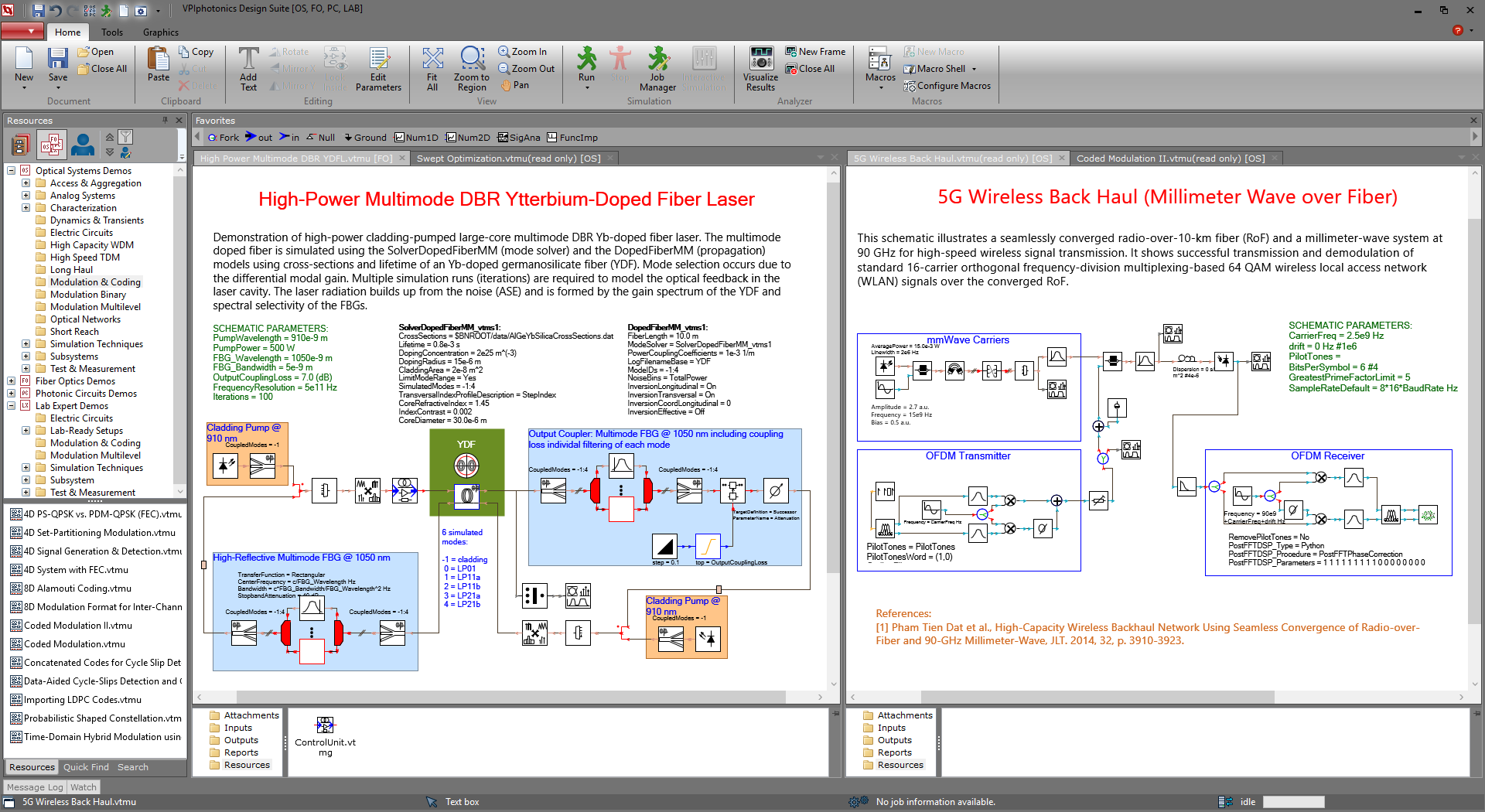Note: An updated version of VPIphotonics Design Suite 9.8 is available improving the software performance on Windows 10 systems.
Please contact support@vpiphotonics.com for more details!
VPIphotonics Design Suite Version 9.8 provides access to professional application-specific simulation tools and several pluggable toolkit extensions with common usability, design process and data analysis capabilities.
Among the new features compared to the previous versions are enhancements of the user interface and tools operation, in particular the new web access API and swept optimization mode, as well as advances in simulation capabilities comprising new design and analysis tools for multimode fibers, amplifiers and other components, dedicated modules for PAM applications, new DSP functionalities, extended library of PIC elements, and many more.
VPIphotonics’ software solutions are utilized by numerous commercial companies and educational institutions for winning and successfully performing a diversity of research and design projects. With the improved capabilities provided in Version 9.8, VPIphotonics Design Suite continuously supports its existing and addresses even new applications and markets.

Photonic Design Environment (PDE) of Version 9.8
DML for PAM – New data-sheet model for directly modulated lasers driven by multilevel data signals as used in Pulse Amplitude Modulation applications
MLSE for PAM – enhanced Maximum Likelihood Sequence Estimation module to support multilevel signals as used in PAM applications
Sync of reference data – new functionality to better synchronize received and reference bit sequences for Digital Signal Processing and BER estimation
DAC and ADC performance – optimized algorithms of Digital-Analog and Analog-Digital Converters to improve computation performance
Scrambler – new DSP algorithm added to the library to perform scrambling of input symbols
DSP over multiple blocks – new DSP mode supporting processing of successive signal blocks by adaptive equalizers such as Carrier Phase Recovery and multi-input multi-output Time Domain Equalizers
Multimode fiber – enhanced to support simulation of coupling between different mode groups
Test set MM – new analysis tool for linear frequency-dependent transmission properties of multimode components and links
Doped MM fiber solver – enhanced to support cross-sections spectra of various 2-levels rare-earth dopant ions, besides Erbium ions
Doped MM fiber propagator – improved ability to analyze and design properties of multimode amplifiers, especially to visualize and save properties of the cladding mode
Test set MM amplifier – new analysis tool for multimode optical amplifiers to characterize gain, noise figures, mode-resolved signal and noise powers, OSNRs, and BERs
Electro-optic modulator – new bidirectional electro-optic amplitude and phase modulator module allowing to control the electro-absorption and -refraction effects in waveguides (for travelling-wave modulators or lengthy Mach-Zehnder interferometers)
Arbitrary bend waveguide – enhanced module to support simulation of curved waveguides with arbitrary shapes accounting for bend-induced dependencies of effective index and attenuation
Library of bend waveguides – library of waveguides with frequently used curvature shapes such as arcs with constant curvature, sine-based, cosine-based, and double-arc S-bends
Arrayed Waveguide Gratings – new AWG module with N inputs and M outputs employing the scattering matrix approach based on datasheet or measured data; no need to provide design-specific information such as waveguide dimensions and materials
Pump source – new realistic module of single and multi-wavelengths pump sources with finite bandwidth for Raman and doped fiber amplifiers
Web access to user interface functions – perform user interface scripting from any remote computer, using a special API based on web technology
Swept optimization mode – set up automated simulation runs combining one-dimensional parameter optimization (find min, max, target) within multilevel parameter sweeps
Icon editor – sophisticated vector graphics editor for custom-created modules and sub-circuits supporting various graphical primitives, and import from library of templates and other existing resources
VPIpython – automated deployment, configuration and management of extendable Python environment including libraries to run macros, simulation scripts and for cosimulation
NVIDIA CUDA library v8.0 – support of GPU-assisted simulations utilizing graphic cards by NVIDIA with Pascal architecture (such as Tesla P100), beside older architectures
Analyzer display schemes – new VPIphotonicsAnalyzer display themes facilitating preparation of graphics for publications based on publisher's requirements (OSA and IEEE)
Many new demonstrations have been added and existing ones modified to illustrate new functions and applications. Version 9.8 provides access to over 850 ready-to-run demonstrations now.
This demonstration illustrates the principle of high-speed transmission using Stokes vector modulation combined with direct-detection receivers.
Modulation in the Stokes space is attractive for high-speed access or metro systems as it enables spectrally efficient modulations while using low-cost
receiver architectures [1]. Here, the sensitivity of several formats, distinguished by combinations of (s1,s2,s3) symbols, is compared at different
spectral efficiencies.
[1] Kikuchi, Kazuro, and Shojiro Kawakami. "16-ary stokes-vector modulation enabling DSP-based direct detection at 100 Gbit/s." Optical Fiber Communication
Conference. Optical Society of America, 2014.